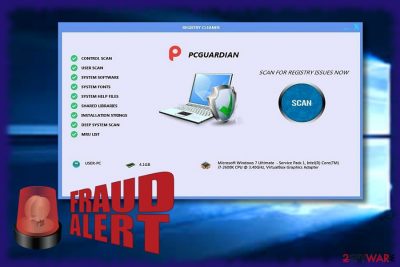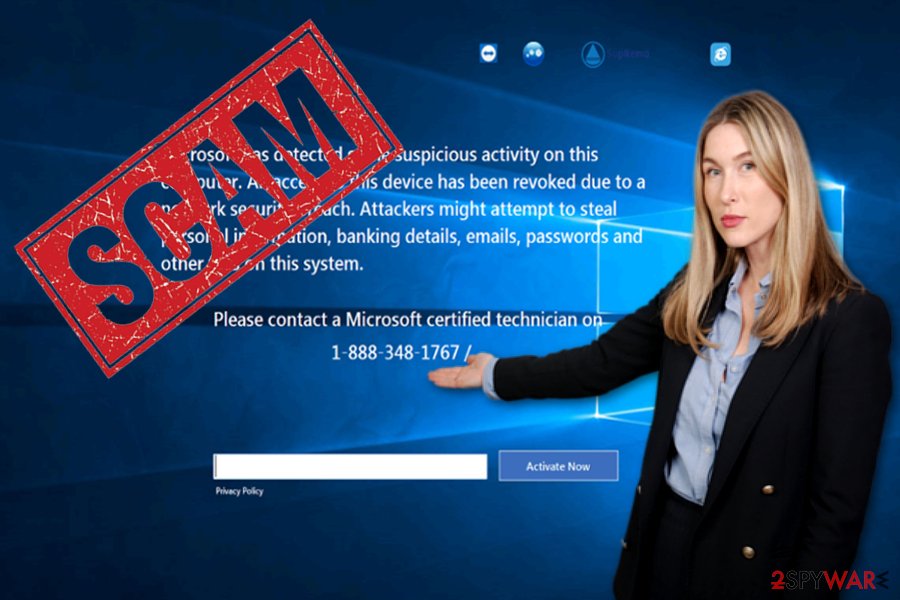PCGuardian Registry Cleaner (Removal Guide) - Free Instructions
PCGuardian Registry Cleaner Removal Guide
What is PCGuardian Registry Cleaner?
PCGuardian Registry Cleaner drops a “gift” – tech support scam – in users PCs

PCGuardian Registry Cleaner is not even considered to be a PC optimizer but rather a rogue and malicious tool. While there are ample of fake anti-virus[1] and highly questionable PC optimizers, only some of them indeed cause severe outcomes.
Unfortunately, this software is one of them and should not be trusted as a tool that can effectively remove outdated registry entries or similar data. In fact, this software is likely to be categorized as scamware as it engages in showing fake alerts in order to frighten users and make them pay for the full version.
| Name | PCGuardian Registry Cleaner |
| Type | Potentially unwanted program |
| Related process | PCGuardian.exe |
| Infiltration | Installed along other software downloaded from shady websites |
| Removal | Perform a full system scan with antivirus software (access Safe Mode if required) |
| System recovery | Rogue programs might mess up Windows system files and registries, resulting in crashes, errors and other stability issues. If you spot these symptoms, use FortectIntego to fix virus damage efficiently |
If unsuspecting users install the application, it will, later on, launch its main executable WMPNetworksSvcx.exe. As a result, after restarting the system, the affected user will see a counterfeited Microsoft log-in screen indicating that the company has detected “some suspicious” unwanted activity:
Microsoft has detected some suspicious activity on this computer. All access to this device has been revoked due to network security breach. Attackers might attempt to steal personal information, banking details, emails, passwords and other files on the system.
Please contact a Microsoft certified technician on
1-888-348-1767 /
This is the typical example of a tech support scam[2]. Note that none of the official Microsoft notifications include any phone number. Such a message does not suggest installing any remote control apps as Team Viewer, Supremo, etc. Thus, make sure to remove PCGuardian Registry Cleaner right away and then fix the damage caused to Windows. FortectIntego or Malwarebytes will help you do that faster.
Tech support scammers join forces with rogue software developers
While there are indeed several questionable PC optimizers and registry repair tools available on the Web, the fact that now such developers cooperate with felons of tech support scams is quite alarming.
Unfortunately, the PCGuardian Registry Cleaner virus is not the one case. Windows Antivirus Helper has also been labeled as a malicious tool that does not even bother users with fake warnings about malicious activity detected but also interferes with legitimate Windows and PC processes.
Furthermore, though it is not difficult to recognize a tech support scam, their elimination may not always be easy. There have been cases when some fraudsters even planted ransomware[3] along with a tech support scam. Thus, you should not delay the removal process of this program.

Distribution peculiarities
Some of the less aggressive tools can be promoted in Chrome web Store or other legitimate sources. However, in the majority of cases, such questionable PC optimizers and anti-virus apps cling to free applications.
If users do not pay enough attention to the installation wizards, they may install highly unwanted software. In order to detect such PUPs on time, opt for “Custom” settings and then remove the checkmarks from unwanted applications. Likewise, keep in mind that “Advanced” or “Default” mode might include optional components that you can't get rid of otherwise.
Delete all malicious programs from your system
In case you have not reported the OS yet, and no tech support scam screen popped up, look for the application in the list of system apps and uninstall it. Otherwise, if you cannot exit the counterfeited scam site, you will need to apply several elimination techniques.
If a manual PCGuardian removal guide is not helpful, let an anti-malware tool eliminate the malware. Reboot the system and tap on F2 or F8 to enter advanced boot settings. Select Safe Mood with Networking and install an anti-spyware tool.
You should delete the related registry entries as explained below. However, since incorrect modifications might cause Windows to malfunction, we strongly recommend employing FortectIntego or another repair tool to clean it.
- Once you are still in Safe Mode, click on Windows key+R and type regedit.
- Once Registry Editor launches, choose Edit and then Find Next.
- Type PCGuardian and delete any remaining folder or registry entries.
On the final note, note that PCGuardian Registry Cleaner malware does not target specific users. Even if you reside in Denmark[4], beware of this scam.
Getting rid of PCGuardian Registry Cleaner. Follow these steps
Manual removal using Safe Mode
Important! →
Manual removal guide might be too complicated for regular computer users. It requires advanced IT knowledge to be performed correctly (if vital system files are removed or damaged, it might result in full Windows compromise), and it also might take hours to complete. Therefore, we highly advise using the automatic method provided above instead.
Step 1. Access Safe Mode with Networking
Manual malware removal should be best performed in the Safe Mode environment.
Windows 7 / Vista / XP
- Click Start > Shutdown > Restart > OK.
- When your computer becomes active, start pressing F8 button (if that does not work, try F2, F12, Del, etc. – it all depends on your motherboard model) multiple times until you see the Advanced Boot Options window.
- Select Safe Mode with Networking from the list.

Windows 10 / Windows 8
- Right-click on Start button and select Settings.

- Scroll down to pick Update & Security.

- On the left side of the window, pick Recovery.
- Now scroll down to find Advanced Startup section.
- Click Restart now.

- Select Troubleshoot.

- Go to Advanced options.

- Select Startup Settings.

- Press Restart.
- Now press 5 or click 5) Enable Safe Mode with Networking.

Step 2. Shut down suspicious processes
Windows Task Manager is a useful tool that shows all the processes running in the background. If malware is running a process, you need to shut it down:
- Press Ctrl + Shift + Esc on your keyboard to open Windows Task Manager.
- Click on More details.

- Scroll down to Background processes section, and look for anything suspicious.
- Right-click and select Open file location.

- Go back to the process, right-click and pick End Task.

- Delete the contents of the malicious folder.
Step 3. Check program Startup
- Press Ctrl + Shift + Esc on your keyboard to open Windows Task Manager.
- Go to Startup tab.
- Right-click on the suspicious program and pick Disable.

Step 4. Delete virus files
Malware-related files can be found in various places within your computer. Here are instructions that could help you find them:
- Type in Disk Cleanup in Windows search and press Enter.

- Select the drive you want to clean (C: is your main drive by default and is likely to be the one that has malicious files in).
- Scroll through the Files to delete list and select the following:
Temporary Internet Files
Downloads
Recycle Bin
Temporary files - Pick Clean up system files.

- You can also look for other malicious files hidden in the following folders (type these entries in Windows Search and press Enter):
%AppData%
%LocalAppData%
%ProgramData%
%WinDir%
After you are finished, reboot the PC in normal mode.
Finally, you should always think about the protection of crypto-ransomwares. In order to protect your computer from PCGuardian Registry Cleaner and other ransomwares, use a reputable anti-spyware, such as FortectIntego, SpyHunter 5Combo Cleaner or Malwarebytes
How to prevent from getting malware
Stream videos without limitations, no matter where you are
There are multiple parties that could find out almost anything about you by checking your online activity. While this is highly unlikely, advertisers and tech companies are constantly tracking you online. The first step to privacy should be a secure browser that focuses on tracker reduction to a minimum.
Even if you employ a secure browser, you will not be able to access websites that are restricted due to local government laws or other reasons. In other words, you may not be able to stream Disney+ or US-based Netflix in some countries. To bypass these restrictions, you can employ a powerful Private Internet Access VPN, which provides dedicated servers for torrenting and streaming, not slowing you down in the process.
Data backups are important – recover your lost files
Ransomware is one of the biggest threats to personal data. Once it is executed on a machine, it launches a sophisticated encryption algorithm that locks all your files, although it does not destroy them. The most common misconception is that anti-malware software can return files to their previous states. This is not true, however, and data remains locked after the malicious payload is deleted.
While regular data backups are the only secure method to recover your files after a ransomware attack, tools such as Data Recovery Pro can also be effective and restore at least some of your lost data.
- ^ Rogue security software. Microsoft. Official site.
- ^ Nicole Henderson. Microsoft Warns Users to be Diligent as Tech Support Scams Get More Sophisticated. IT Pro Windows. Microsoft Windows Information, Solutions, Tools.
- ^ Danny Palmer. Now tech support scams are exploiting WannaCry ransomware fears. ZDnet. Technology news, analysis, and comments.
- ^ Eliminate malware. Udenvirus. Spyware and security news in Dannish.














